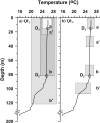Estimation of Mixed Layer Depth in the Gulf of Aden: A New Approach
- PMID: 27788181
- PMCID: PMC5082926
- DOI: 10.1371/journal.pone.0165136
Estimation of Mixed Layer Depth in the Gulf of Aden: A New Approach
Erratum in
-
Correction: Estimation of Mixed Layer Depth in the Gulf of Aden: A New Approach.PLoS One. 2017 Mar 2;12(3):e0173545. doi: 10.1371/journal.pone.0173545. eCollection 2017. PLoS One. 2017. PMID: 28253343 Free PMC article.
Abstract
The mixed layer depth (MLD) in Gulf of Aden is analyzed using vertical high resolution (1m) profiles of both temperature and density. Firstly, we examined threshold and gradient methods for estimating the MLD. Close evaluation with individual profiles reveals the failure of both methods for most of the profiles. Furthermore, the curvature method, a relatively recent approach to define ocean MLDs, is established for open water profiles but for marginal seas, like the Gulf of Aden, it detects shallower depths than the actual MLD. These considerable differences motivated us to introduce a new approach of MLD identification, which is developed based on curvature method and is called segment method. Our segment method produces adequate MLD estimates for more than 95% of the profiles and overcomes major limitations of conventional methods. It is less biased and least scattered compared to other methods with a correlation coefficient > 0.95. The mixed layer in Gulf of Aden displays significant seasonal variability and is deeper in winter. Throughout the year, the western part of gulf experiences deeper mixed layer than the eastern part. Regional eddies dominate Gulf of Aden's MLD pattern during all seasons.
Conflict of interest statement
The authors have declared that no competing interests exist.
Figures









References
-
- Cury P, Roy C. Optimal Environmental Window and Pelagic Fish Recruitment Success in Upwelling Areas. Can J Fish Aquat Sci. NRC Research Press Ottawa, Canada; 1989;46: 670–680. 10.1139/f89-086 - DOI
-
- Robinson CLK, Ware DM, Parsons TR. Simulated annual plankton production in the northeastern Pacific Coastal Upwelling Domain. J Plankton Res. 1993;15: 161–183. 10.1093/plankt/15.2.161 - DOI
-
- Wijesekera HW, Gregg MC. Surface layer response to weak winds, westerly bursts, and rain squalls in the western Pacific Warm Pool. J Geophys Res. 1996;101: 977–997.
-
- Kara AB, Rochford PA, Hurlburt HE. An optimal definition for ocean mixed layer depth. J Geophys Res. 2000;105: 16803 10.1029/2000JC900072 - DOI
-
- Kara AB, Rochford PA, Hurlburt HE. Mixed layer depth variability over the global ocean. J Geophys Res. 2003;108: 1–15. 10.1029/2000JC000736 - DOI
MeSH terms
LinkOut - more resources
Full Text Sources
Other Literature Sources

